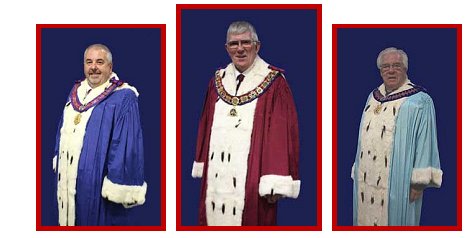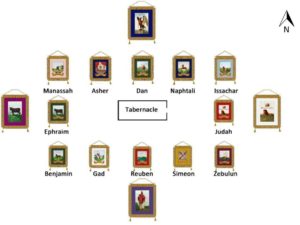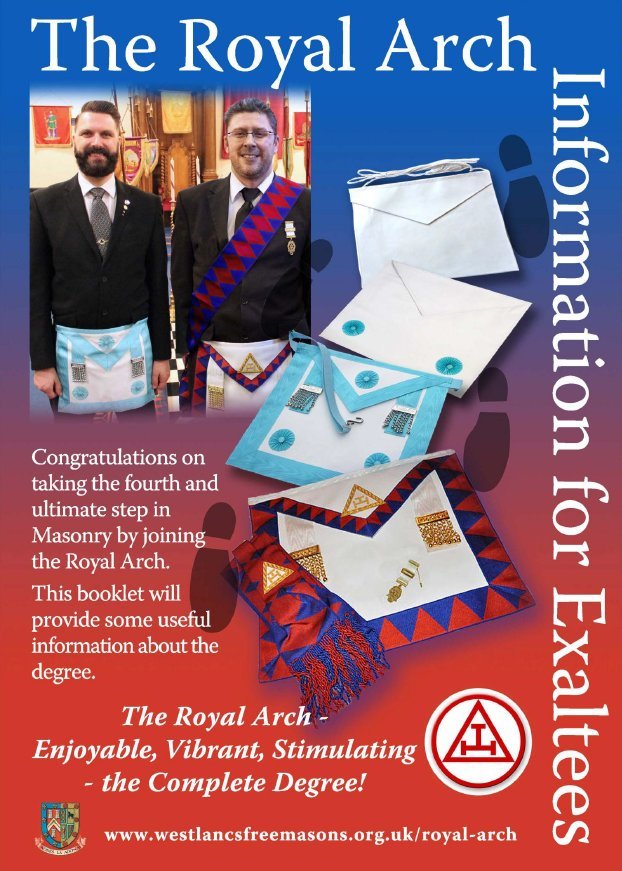
Principals’ Robes, Sceptres and Titles
Other Officers and their Functions
Valedictory or Closing Address
Explanation of the Chapter Certificate
Foreword
Companions,
The Royal Arch, Enjoyable, Vibrant, Stimulating – the Complete Degree!
This booklet is intended to provide further information, on the Royal Arch, particularly for new members of this colourful order. It is generally issued under a letter from the Deputy Grand Superintendent and your local RA Assistant, marking a Companion’s Exaltation.
The Royal Arch is different from the three Craft degrees which precede it and understanding it more fully, can only add to a Companion’s enjoyment of it.
We hope that you find this booklet of some benefit as you progress and continue to enjoy your RA Freemasonry. Please visit www.westlancsfreemasons.org.uk/royal-arch regularly to further your daily advancement in Royal Arch masonry.
We congratulate you on taking the Next Step in Freemasonry and trust that this booklet will prove to be a useful and informative companion.
Issued on behalf of the RA Cabinet.
Acknowledgements
This booklet is based on an original, produced for the St Helens & Prescot Group of Lodges.
The Royal Arch Cabinet is most grateful to E Companion Frank Davies, PGStB and E Comp Colin Rowling, PGStB, Assistant to the Provincial Grand Principals, for allowing the Cabinet to utilise their booklet in an amended form, for use throughout the Province and also to EComp Stanley Oldfield PAGSoj. P3rdPrGP for his explanation therein of the Grand Chapter Certificate.
It provides an invaluable explanation to much of what constitutes the Royal Arch and should particularly help new Companions, in gaining a greater understanding of it.
Their original research and efforts are much appreciated.
Introduction
These notes have been compiled for the average Companion and he can delve more deeply into other works if the mood takes him.
Whilst it is true that there are very many Old Testament references which can be quoted in support of Royal Arch explanations, the fact remains that much of the significance is open to interpretation – it is still veiled in allegory and illustrated by symbols.
It is also true that we do not know just how the ceremonial part of Royal Arch came into being. Many theories have been advanced but none can be substantiated or proven to be factual.
Early days of the Royal Arch
Some historians have stated that Royal Arch was in existence during the early part of the 18th century, but there is no factual evidence for this. The first recorded exaltation is dated 1753. Remember that just two years earlier, a second Grand Lodge (calling itself “The Antients”) had been formed by disaffected Irish Masons as a direct rival to the premier Grand Lodge which they called, rather scornfully “The Moderns”. This new body argued that the Royal Arch was a fourth degree and allowed their lodges to work it under the authority of the craft Warrant.
On the other hand, the premier Grand Lodge officially did not recognise the Royal Arch and would have nothing to do with it. Despite this denial, there is evidence that many of their lodges did in fact work it alongside their normal ceremonies. Lodges who owed first allegiance to the premier Grand Lodge but who also embraced some of the Antients workings were known as “Traditioner Lodges”. (Lodge of Loyalty No. 86 (Modern) being a good example, where a member’s plate jewel, known to date from 1782-1797 clearly shows an Arch; the museum at Grand Lodge has Chapter minutes dated 1803 and lists of Chapter members dated 1807, long before the 1813 union which legitimised Royal Arch, but a Chapter Warrant was only applied for in 1851).
For a time, a situation existed where some very senior officers of the premier Grand Lodge spoke openly and in public against the Royal Arch when in fact, they had secretly joined the Order.
Later, seeing just how popular the Royal Arch had become and wishing to exercise some control over its growth and development, the Moderns formed the first Grand Chapter in 1766 – the “Excellent Grand and Royal Chapter of the Holy Royal Arch of Jerusalem” – the forerunner of today’s Supreme Grand Chapter.
The new Grand Chapter was designed to be totally independent of the premier Grand Lodge (separate management, finances, regulations etc.) the only link with the premier Grand Lodge was that Chapters could draw their members from lodges under that body. This “separation” proved to be a decisive factor when it came to negotiations surrounding the unification of the two Grand Lodges.
Finally, when the Antients and Moderns became one in 1813, the Moderns had given way on almost every point of difference which had caused the division some 60 years earlier EXCEPT the Royal Arch where they were determined that it would not have the same status as the three craft degrees, hence the compromise statement of 1813 that “Antient Masonry consists of three degrees and no more, namely the Entered Apprentice, the FellowCraft and the Master Mason, including the Supreme Order of the Holy Royal Arch.”
Governance of Royal Arch
The governing body of the Royal Arch is the Supreme Grand Chapter. It has the equivalent authority for this Order in exactly the same way that the United Grand Lodge governs Craft Masonry throughout the world. Both Supreme Grand Chapter and Grand Lodge have their headquarters in Freemasons’ Hall in London.
The head of Royal Arch is HRH the Duke of Kent who is known as The Most Excellent First Grand Principal.
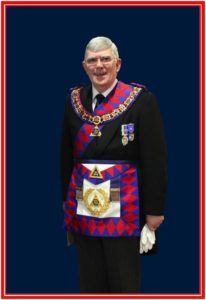
In the Province of West Lancashire, the Provincial Grand Master is also the head of Provincial Grand Chapter.
He is known as the Most Excellent Grand Superintendent and E.Comp. James Anthony Harrison is pictured here.
In many other Provinces (some much smaller than West Lancs), the offices of Grand Superintendent and Provincial Grand Master are held by different brethren.
You may ask why such a large Province as ours has not followed suit which would relieve the workload of a very busy Provincial Grand Master, but the decision to hold both offices is entirely his.

Our Province has a Deputy Grand Superintendent
who is E.Comp. Dr Paul Andrew Renton.
The Second Provincial Grand Principal is E.Comp. Chris Butterfield and the Third Provincial Grand Principal is E.Comp. Rev Canon Godfrey Hirst.
The Three Provincial Grand Principals and their sceptres
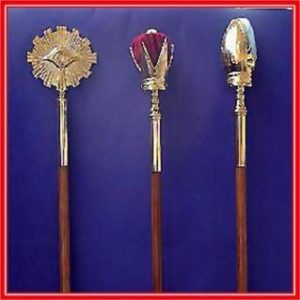
These Principals are in turn supported by six Assistants who are responsible for several Groups covering the whole Province:

1. Barrie Crossley, responsible for the Furness and South Lakeland and Lancaster and District Groups.
2. Sam Robinson, responsible for the Liverpool, Garston, Gladstone and Woolton Groups.
3. Tony Hall, responsible for the Chorley and District, Leyland and District, Ormskirk, Bootle and Southport Groups.
4. Colin Rowling, responsible for the Eccles and District, South Eastern, St Helens and Prescot, Widnes and Warrington Groups.
5. Duncan Smith, responsible for the North and South Fylde and Blackpool Groups.
6. Mike Threlfall, responsible for the Wigan and District, Preston and Leigh Groups.
Your Exaltation Ceremony
It is likely that much of what went on during your exaltation is still a blur, it is worth spending a few moments trying to re-live the experience for you.
Your ceremony was in three parts and although the furniture of the Chapter stays the same, the location is different in each part – moving from a building site to The Grand Sanhedrin.
The first part was set in Jerusalem about 520 BC at the time when the descendants of the children of Israel, led by Zerubbabel are returning from their captivity by the Babylonians only to find that the Temple erected by King Solomon had been completely destroyed and the city in ruins.
You were told that … …
“The story about to unfold builds on, and is inextricably linked to, your three Degrees in Craft Masonry. It takes place some 500 years after the dedication of Solomon’s Temple. King Solomon has long since died. Jerusalem has been attacked by the Babylonians, the city and its once magnificent temple have been destroyed and its inhabitants taken into captivity into Babylon where they remained for 70 years.
We are now at that period in history where the Babylonian Empire itself has been attacked and defeated by Cyrus, King of Persia. Cyrus has recently issued a decree allowing the descendants of the Hebrew exiles to return to Jerusalem. As a candidate for Exaltation, you represent one of those exiles returning to Jerusalem as a Sojourner or Journeyman builder. You will discover that the Temple and Holy city are in ruins and, with your colleagues, offer your assistance in building a new temple when, as you will eventually see, a discovery of very great importance is made.”
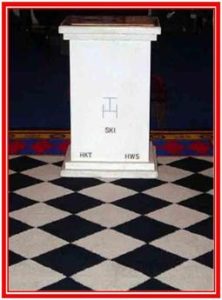
In this first part, you were entrusted with the passwords leading to this Supreme degree and were admitted to the Chapter, blindfolded and wearing your badge as a Master Mason. You were assisted on this new journey of discovery by a Principal Sojourner (a journeyman mason) and finally arrived at the crown of a vaulted chamber situated on the site of the old Temple.
You were symbolically lowered into the vault to enable you to have a look at the contents, but before proceeding further you were required to take an obligation; you were then restored to light when, in some Chapters, you might have seen the Companions arranged around the ensigns which were often tilted inwards to symbolise their support and encouragement for you on your journey. You saw again the chequered pavement representing alternate light and dark and which is familiar to you from Craft masonry. The end of your journey was symbolised by the pedestal bearing the Sacred Name whilst the triangle, created by the Principals‟ sceptres, is emblematic of the Creator.
You were then allowed to leave the Chapter.
In the second part, you were readmitted as one of three Sojourners, members of the tribe of Judah, who having heard that the Temple was about to be re-built, offer their assistance and are given the task of preparing the ground for the foundation of the new Temple. You were told that
“You will shortly return to the Chapter as one of the three Sojourners journeymen builders. You will go right back to the start of the story but, this time, you will not be hoodwinked and therefore be able to see what happened in the previous part of the ceremony. Whilst the scenery in the Chapter has not changed, the room now represents the Grand Sanhedrim, the Council of 72 Elders which sat together to regulate the affairs of the Temple and the religious life of the Jews. Zerubbabel presides, with Haggai and Joshua. You now represent the Council Members. You have to imagine that the secret vault, represented by the carpet and its equipment, is still undiscovered under the foundations of the former temple building.
Cyrus has issued his decree allowing the exiles to return to Jerusalem. You, as one of the three Sojourners, are about to arrive from your captivity in Babylon, having heard that the Temple is about to be rebuilt, to offer your services in that great and glorious undertaking.”
The third part was enacted in the Grand Sanhedrin – the Supreme Council consisting of 72 members which sat together to regulate affairs of the Temple and religious life of the Jews and before entering you were told
“As one of the Sojourners you were given one of the implements of labour as you left the room. Figuratively you will prepare the ground for the foundation of the second temple when you return to the Chapter. The room still represents the Grand Sanhedrim but, the secret vault represented by the carpet and other equipment will now become the focal point of the story. The Sojourners, as members of the princely tribe of Judah, (the elite) were given the heavy and menial task of clearing the ground for the foundations of the second Temple.
Doing so they make an important discovery, as you will soon see. A lesson that truly humble workmen, though engaged on unskilled and uninteresting work, may nevertheless find in it great reward entitling them to a place among the wisest of men in the Council of Rulers. Traditionally, the Grand Sanhedrin was the Council of Princes and Rulers of the people set up by command of God to assist Moses. The word Sanhedrin means, ‘the body of elders’, its foundation is recorded in the Bible – Numbers, Chapter 11.
You, as the Candidate, will be rewarded and presented with a staff of office which you will ever have the right to bear it unless 72 of the Elders are present. You might therefore be interested in the details of Royal Arch Regulation 48 which states: ‘According to ancient custom a complete Chapter of this Order of Freemasonry consists of Three Principals who, when in Chapter assembled are to be considered conjointly as the Master and each severally as a Master, two Scribes, a Treasurer, A Principal Sojourner, two Assistant Sojourners, and other companions, making up the number 72 as a Council: and no regular Chapter can consist of more; but any number may be elected, exalted and received as Companions with all the privileges of membership save they are not to hold the staff of office or to be considered as Councillors when more than 72 are present. You will now hear a detailed dramatic account of how that discovery was made.”
Your colleague then gave an explanation as to how the hidden vault was re-discovered and the dramatic discovery of its long-lost contents when the Sanhedrin rewarded you for your part in discovering the lost secrets – the word of a Master Mason and a seat amongst them.
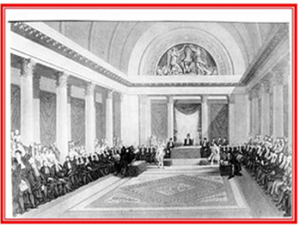 The Grand Sanhedrin of Napoleon in 1807
The Grand Sanhedrin of Napoleon in 1807
Principals’ Robes, Sceptres and Titles
A Royal Arch Chapter is ruled by three officers known as Principals, who together constitute the Master, though each separately is considered to be a Master.
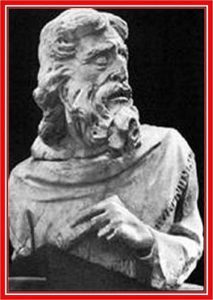
The First Principal, Zerubbabel, Prince of Jerusalem, is referred to in Chapter as Most Excellent and wears a scarlet robe and carries a sceptre bearing a crown.
(Pictured Zerubbabel from a painting in the Sistine Chapel)
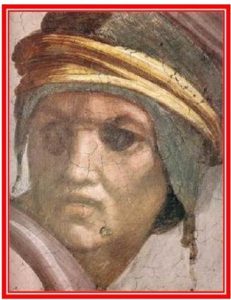
The Second Principal, Haggai, the Prophet, is addressed in Chapter as Excellent Companion Haggai (Hag-eye), who wears a purple robe and carries a sceptre bearing the All-Seeing Eye.
(Pictured Haggai from a bust in the S Maria Cathedral)
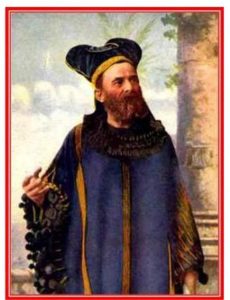
The Third Principal, Joshua, the High Priest, is addressed in Chapter as Excellent Companion Joshua; he wears a light blue robe and carries a sceptre bearing a bishop’s mitre.
(Pictured Joshua from a bible illustration)
When addressing the Chapter, a Director of Ceremonies or any other, a speaker will say, “Most Excellent, your Excellencies and Companions.”
The VSL tells us that Zerubbabel and Joshua, (not to be confused with the Joshua who succeeded Moses) were instrumental in building the Temple at Jerusalem after returning from Babylon and Haggai was the Prophet who foretold the rebuilding of it.
Other Officers and their functions
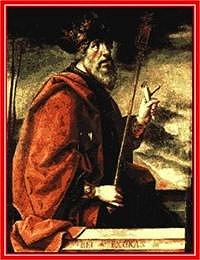
According to ancient custom, apart from the three Principals, the other officers are the two Scribes, Ezra (Scribe E, equivalent to a lodge secretary) and Nehemiah, (Scribe N, who acts in a joint capacity like a Warden and Inner Guard), a Treasurer, a Principal Sojourner and two Assistant Sojourners, (Sojourner means a journeyman mason who arrives as a stranger intending to move on in due course.)
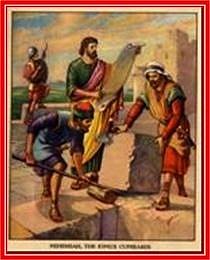
In addition, a Director of Ceremonies, an Almoner, a Charity Steward, an Assistant Director of Ceremonies, an Organist, an Assistant Scribe E and Stewards may be appointed.
The Janitor (equivalent to the Tyler) is elected.
The sign
The Reverential Sign in the Royal Arch is only ever used when entering or retiring from the Chapter and always given to the name on the pedestal – not to the Principals. The right thumb should always be DOWN (even during obligations and prayers) and the left thumb ALONG the forehead and not to the side. Thus, the thumb is always hidden.
So, a Sojourner who retires to prepare a candidate simply gives a “court bow” before leaving and another on his return. Similarly, when Scribe E is asked for e.g. the minutes of the previous Convocation, he too, does not salute but offers a court bow before proceeding.So, a Sojourner who retires to prepare a candidate simply gives a “court bow” before leaving and another on his return. Similarly, when Scribe E is asked for e.g. the minutes of the previous Convocation, he too, does not salute but offers a court bow before proceeding.
A Janitor, however, entering to receive his collar and jewel of office, salutes the name on the pedestal and does so again when retiring.
Similarly, a latecomer salutes on entry and anyone leaving early does the same.
Remember too that the sign is always discharged before speaking.
In summary then, when any officer addresses the Principals, a court bow (no body movement – just a nod of the head) is all that is needed.
There are no salutes in the Royal Arch.
The Triple Tau
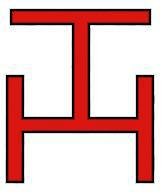 This is the easily recognisable symbol of the Royal Arch. The Tau, is the Greek letter T and comes at number 19 in their alphabet.
This is the easily recognisable symbol of the Royal Arch. The Tau, is the Greek letter T and comes at number 19 in their alphabet.
The first time that you saw the Triple Tau was when you were restored to light and you would have seen it at the base of the pedestal.
It used to be written as a T over an H but gradually the letters lost their “serifs” and the tail of the “T” dropped onto the crossbar of the “H”. Now the legs are all a regular size and it has a symmetrical configuration.
Early explanations stated that it referred to Templum Hierosolymae (the Temple at Jerusalem). In the Scottish Constitution, it shows that the wearer is a believer in the true God, the God of Israel.
Also at the bottom of the pedestal were the initials of the three Grand Masters who presided over the building of the first Temple, namely, Solomon King of Israel, Hiram King of Tyre and Hiram Abiff.
The Royal Arch Jewel
The jewel for a Past Principal is the same as that of a Companion – but the ribbon colour is different (see later).
 The design of the jewel consists of two sets of concentric circles– a larger set within which is a pair of triangles making a Star of David and a smaller set of circles at the bottom surrounding a Triple Tau.
The design of the jewel consists of two sets of concentric circles– a larger set within which is a pair of triangles making a Star of David and a smaller set of circles at the bottom surrounding a Triple Tau.
There are some inscriptions on the jewel as follows: –
On the obverse (front), inside the larger circles, is engraved the motto of the Order, namely Si Talia jungere possis sit tibi scire satis which translates as – If you would understand these things you would know enough.
Inside the scroll and lower circles surrounding the Triple Tau is engraved Nil nisi clavis deest meaning Nothing is wanting but the key.
Along the legs of the triangles is We have found with a translation into Latin along another side and a further translation into Greek on the third. This of course refers to the discovery by the Sojourners.
There is also Cultor Dei and then Civis Mundi meaning A worshipper of God and Citizen of the world respectively, both of which reflect the status of you, the exaltee. The third leg is blank so that your name can be engraved in it. Much of this engraving can be found on the earliest known Royal Arch Jewel dated 1765 which can be seen in the Museum of United Grand Lodge.
On the reverse, within the large concentric circles is Deo regit fratribus honor fidelitas benevolentia meaning To God, the King and the Brethren be honour, fidelity and benevolence. Note the use of “Brethren”.
On the legs of the triangles are Wisdom, Strength, Beauty, Peace, Concord and Truth.
On the scroll at the lower left-hand side is the word Exalted and you could engrave the date of your exaltation in the right-hand space.
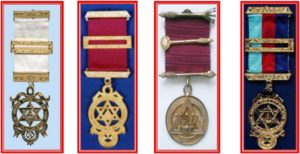
There are four breast jewels as shown above – as a Companion, your ribbon is white.
When you become a Principal, the ribbon is changed to maroon. After your year in the first Principal’s chair you may wear a Past Zerubbabel’s jewel, but only in your own Chapter. Finally, as a Provincial or Grand Officer, the ribbon becomes three coloured – dark blue, maroon and light blue. The latter colour should always be on the inside i.e. nearest the heart and in doing so, mirrors the colour sequence of the collarette.
The Holy Royal Arch is the only other Order recognised by Grand Lodge and the only other Order jewel permitted to be worn in Craft lodges.
Regalia
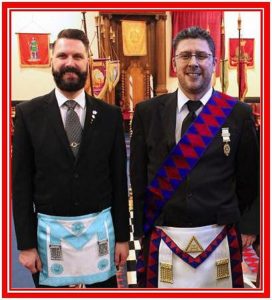
All Royal Arch Masons wear the same regalia, but with differing colour combinations.
First a sash over the left shoulder, possibly representing the holder of a scabbard for a sword, for the Old Testament tells us that the children of Israel built the Temple with a trowel in their hand and a sword by their side.
A sash is also a fundamental part of the regalia of an Order.
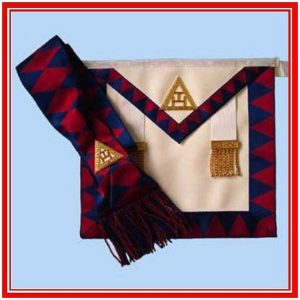
The sash differs when you become a Principal because the background colour of the Triple Tau (on your right hip) changes from white to maroon.
It will change again, this time to blue when you become a Provincial Officer or Grand Officer. Meanwhile, the fringe on the sash changes from red/blue silk to gold or metal gilt.
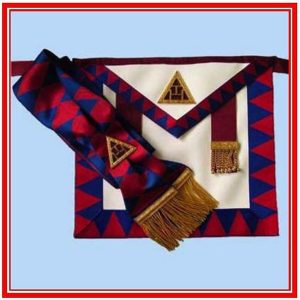
Similarly, a Companion’s apron has white tassels and belt, a Principal (or Past Principal) has maroon tassels and belt and a Grand and Provincial Grand Officer, blue.
The Royal Arch jewel ribbon follows the same pattern of colour changes as you progress – white for a Companion, maroon for a Principal or Past Principal and three colours for a Grand or Provincial Grand Officer.
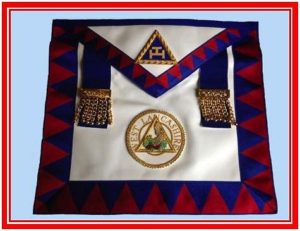
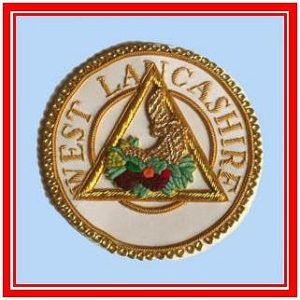
The apron of a Provincial Officer differs from the preceding ones by having blue tassels and a badge showing the rank the Companion was invested with at Provincial Grand Chapter. The pictures below show a Provincial Grand Steward’s apron and badge with the colourful cornucopia.
The Grand Officer’s apron has blue tassels but also a double-edged border on three sides and bears the rank which was conferred at Supreme Grand Chapter in London.
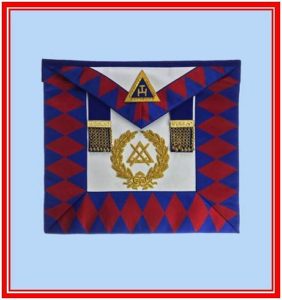
This apron shows the wearer holds the rank of Past Grand Sword Bearer.
However, Companions who have rendered long and distinguished service to the Order but have never served as the Principal of a Chapter, may receive Provincial honours. These Companions will wear a Companion’s jewel (white ribbon), a special sash which will have a silk (red and blue) fringe and blue background for the Triple Tau. They also wear a normal Provincial apron (blue tassels and belt). This is the only occasion when the jewel ribbon, apron tassels and Triple Tau background are not the same colour.
Just as in Craft masonry, some Chapters wear white gloves, others do not.
Some Frequently Asked Questions
Why are we known as Companions and not Brethren?
The simple answer is to make absolutely clear the difference between a member of the Craft and someone admitted to the secrets of the Royal Arch. This clear distinction emphasises the anomaly of calling Royal Arch the completion of the 3rd degree. Since the Royal Arch ceremony was originally performed in a Craft lodge, the members were called brethren until the mid-18th century – and in some places for even longer. Easy then to see how the link between Craft and Royal Arch leads us to use the term brethren when speaking of Royal Arch members.
From where did the colours of the robes originate?
It is said that inside the Tabernacle there were a series of veils which covered the several entrances to the Holy of Holies. The first was blue, then purple and finally scarlet.
So, the robes of the officers of the Order remind us of these veils. In earlier days, there was a ceremony of the veils where the Sojourner would act as a type of Inner Guard and refuse to let anyone enter unless they were in possession of the word and token of the veil. The ceremony of Passing the Veils had fallen into disuse until it was reintroduced into a Chapter in Bristol in the 1920’s and is still widely practised by Chapters in that area. Occasionally it is also performed in West Lancashire with permission.
In some Chapters, Joshua’s robe is light grey which was the colour before the union in 1813 and these Chapters are simply maintaining their old tradition.
Why do we approach the pedestal by that series of steps?
You approach by three, five and seven steps in allusion to the steps you took firstly at your Initiation (3), then at your Passing (5) and finally at your Raising (7).
Why are the Banners and Ensigns so arranged in a Chapter?
It is important to remember that the tribes of Israel were also a formidable army more than capable of looking after themselves and when on the march, they formed a column, but when camped for the evening they would arrange themselves into a defensive formation where there were three tribes at each of the four principal compass points viz. North, South, East and West. Their purpose was to protect their most prized possession – the sacred Tabernacle which was in the centre of the camp.
Each small banner (an ensign) in the Chapter represents a tribe, but we arrange them only along the North and South so that the Principals have a clear view of the Sojourners.
There were also thirteen tribes, so the two smallest, Simeon and Levy, formed into one for the purposes of defence.
The four major banners are usually placed behind the Principals’ chairs.
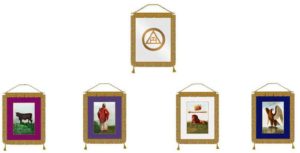
Click image to enlarge
These show an ox, a man, a lion and an eagle.
They were the leading Standards of the four Divisions of the army of Israel and an assembly point for each group of three tribes.
The order in which the banners are displayed varies from Chapter to Chapter, but the arrangement below is that used by Supreme Grand Chapter. Also included is a Triple Tau banner.
They are described in the Book of Genesis – an ox to denote the ministration of patience and industry, a man to personify intelligence and understanding, a lion to represent strength and power and an eagle to display the promptness and speed with which the will and pleasure of the Great I Am are executed.
During the period when the children of Israel had lost their way and were following a path of idolatry, ten of the northern tribes became isolated from the main army through disagreement and squabbles and were easily defeated when the Assyrians invaded and as they were never heard of again are known as the ten lost tribes of Israel.
The remaining two, clearly no match for the Babylonish army when they invaded some time later, were defeated, sent into captivity to Babylon (Iraq) and the city and Temple were razed to the ground.
It was only some seventy years later when Cyrus, King of Persia, who had defeated the Babylonish army and allowed all their prisoners to return home that our story begins.
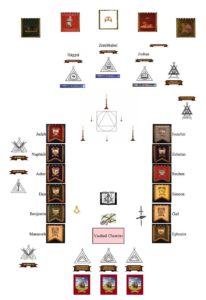 Typical Chapter Layout showing banners, ensigns and collar jewels
Typical Chapter Layout showing banners, ensigns and collar jewels
Click image to enlarge
What are the Sojourners’ banners?
In some Chapters, three ensigns are posted behind each of the Sojourner’s chairs. The ensigns are decorated with the same distinctive bearings as that found on the ensign of the tribe of Judah (a lion couchant with sceptre and crown) and you will recall during the exaltation, the Sojourners convinced the Sanhedrin that they were “nobly born – descended from the royal house of David and the princely tribe of Judah”.
The ensigns are thus meant to represent the Sojourners who had travelled from Babylon and offered their assistance in re-building the temple. Because of this, the ensigns have become known as the Sojourners‟ Banners and can be seen in the preceding illustration behind the Sojourners’ chairs.
Why do the Principals bounce arms?
Putting it simply, we just don‟t know and as is so typical of the Royal Arch, there is very little consistency. Some Chapters don‟t bounce at all; some do it at the opening after the fourth “Agree” whilst others do it after the word has been shared.
An early literature reference has the following explanation (during the sharing of the word with an Exaltee) when the 1st Principal says, “We then preserve the sacred name(s) by again enclosing them in the vault” and there are then four bounces of the arms still in the triangles. Remember that the name(s) has three syllables yet there are four bounces, so it doesn’t help much.
So sadly, when asked this question we’ll just have to fall back on that old chestnut “because we’ve always done it”.
Why are the words different in the opening from those in the closing?
The Principals when arranged in their triangles at opening all say, in turn:
“We three, do meet and agree …. etc” whilst in the closing, again in their triangles, they say in turn “We all do meet and agree …. etc”
The reason is that up to 1902, only Past Principals were allowed to be present in the opening, so when the rules were changed, the words at the closing were altered to reflect that ALL companions were present whilst leaving the opening to reflect early history.
The form of a Royal Arch Chapter approaches a Catenarian arch. What is this?
A catenary curve is the line of sag in, for example, a chain, caused by its own weight when stretched between two points and secured at both ends.
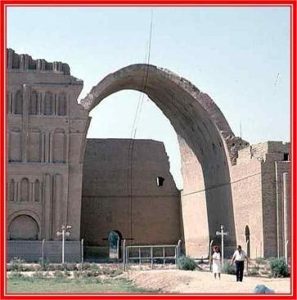
A catenary arch is the inversion of that line and is essentially a weak structure. But please remember that our ritual, being symbolic is not necessarily correct. For example, reference to a catenarian arch was not known in ritual before about 1834 and there is no evidence to suggest that the architects of King Solomon’s Temple had any knowledge of arches or domes. This picture shows a Late Roman catenary arch in Iraq (about 1600 years old) sadly now destroyed by an earthquake.
Despite this, the form of a Royal Arch Chapter is in the form of a catenarian arch if the north and south sides are taken to represent two pillars with the Principals’ chairs in the east connecting them when they are arranged in an arc with Zerubbabel at the apex.
In some Chapters, during the exaltation obligation, the Principals stand in a curved line whilst the Companions tilt the banners inwards to represent a vaulted arch.
Why did Cyrus let them all go home ?
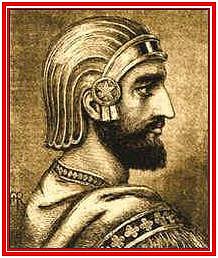
King Cyrus was very wise and forward thinking – a true pragmatist. During the 70 years of their captivity, the hard-working Jews had become fishermen and farmers, and many had educated themselves and held senior positions in the judiciary and other professions. Cyrus needed to re-populate the conquered territory which would then act as another defensive line on an otherwise exposed flank. But, would the released captives not bear allegiance to their former captor if their land was attacked?King Cyrus was very wise and forward thinking – a true pragmatist. During the 70 years of their captivity, the hard-working Jews had become fishermen and farmers, and many had educated themselves and held senior positions in the judiciary and other professions.
Cyrus needed to re-populate the conquered territory which would then act as another defensive line on an otherwise exposed flank. But, would the released captives not bear allegiance to their former captor if their land was attacked?
In addition, Cyrus saw that Babylon was clogged with populations that could be used elsewhere.However, he recognised that if he released them he would have to give them a sense of purpose and so he directed them, in writing, to return home and rebuild their Temple. So, he sent them away, happy and content and therefore more productive to his Empire.Cleverly, he allowed only a few to leave first and then a much larger contingent some time later. It was from this second group that our Sojourners made their offer of help.
In Craft Masonry, we have Working Tools, why don’t we have them in Chapter?
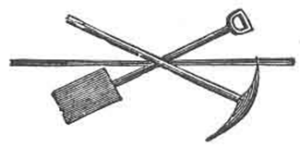
We do, they are the pick, shovel and crow. The pick roots out from our minds all evil thoughts. The shovel clears away from our minds the rubbish of passions and prejudice. The crowbar raises our desires above the interests of this life the better to prepare for the search after knowledge and the reception of truth and religion.
Why is there a limit of 72 elders able to bear the staff of office?
Since they could have run away with their new-found knowledge, it is not surprising that they were rewarded with seats amongst the rulers and princes of the people. However, they were prohibited from holding office if a full Sanhedrin was sitting i.e. 72 members were already in place, as their presence would exceed the total of members comprising the Sanhedrin.
Incidentally, the presentation of a staff of office to a new candidate is not practised by all Chapters throughout the UK.
In the Scripture readings at Installations, the word “Ephod” is used. What is an Ephod?
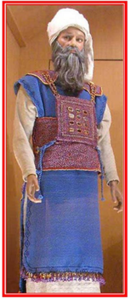
This is an elaborate garment worn by the High Priest upon which a breastplate containing the Urim and Thummim is worn.
The Ephod was made from fine linen, woven from gold, blue, purple and scarlet threads and held together by a belt around the waist and with two shoulder straps fastened to it with gold rings.
The breastplate was then attached with gold chains. In some Chapters, Joshua actually wears this garment and a rather splendid hat or cap.
What are the Urim and Thummim?

It is thought that the Urim (pronounced Oo- rim and Thummim (sometimes pronounced Too-mim) were two discs, perhaps black on one side, white on the other which were slipped into pouches in the breastplate.
They were thought to have been used by the High Priest to predict the outcome of a decision when seeking guidance from the Lord, but just how is very much open to question. Perhaps they were tossed or spun and allowed to fall, whereupon the High Priest would interpret the result – two black – not in favour, two white, a go ahead, but one of each, no decision
Why do we drink our toasts with our left hand?
In some Chapters the Companions drink the loyal toast with the right hand and other toasts with the left. This would seem to be just a quaint custom as it has no Masonic significance but as it does no harm and does not contravene any regulations
In the closing, why do Past Principals “salute” an open bible but Companions a closed one.
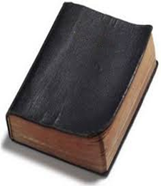
At the closing ceremony, in some Chapters, a bible is passed down each side of the room for all Companions to kiss four times.Companions should salute the closed bible but for all Past Principals the bible is open.The reason is that when we have passed through the chairs in Chapter, the bible is an “open book” whereas for Companions, it suggests that there is more to learn.
Why do we refer to it as Holy Royal Arch?
Firstly, and fairly obviously because of the great emphasis placed on the teachings of the Holy Scriptures. We are aware that there are many Biblical references in Craft, but there are no scripture readings like there are in Royal Arch. In addition, our ritual states that “Man would have remained in a state of darkness had it not pleased the Almighty to call him to light and immortality by the revelation of his HOLY will and word.” The whole narrative of our Order is rooted in Holy Words.
Remember too that the place where the original Holy Temple was built was consecrated ground and so the new Temple was to be built on Holy ground – so Holy in fact, that only those who were duly qualified Children of Israel were permitted to work there – even on the menial task of removing debris.
Think back to your exaltation, the Sojourners were questioned by the Sanhedrim as to their ancestry before being permitted to work on the site.Yet the most significant reason why this is a Holy ceremony is because it is the object of our whole endeavour. Remember your exaltation when the Most Excellent says, “Let us bless, praise and magnify his Holy name for the knowledge vouchsafed in us …” Already the object of your presence has been revealed – you are to uncover the Holy Name of the TALGMH.
This is the summit of all your searching and as the Principals pass on to you in threefold form the full truth of how God is named, so you enter the Holy of Holies where once, only the High Priest could pronounce the same.
This threefold sharing also completes another part of your puzzle – how could the genuine secrets be lost by the death of Hiram when “those secrets were known to but three in the world etc.”? Surely, if the other two knew them they could not be lost!You now know that it was the method of sharing the sacred word that was lost.
Where does the Holy Royal Arch fit in relation to Craft Masonry?
In days gone by we used to tell candidates at exaltation that they had not received a “Fourth Degree in Freemasonry”, but had completed their third degree. Today, we impress upon candidates that the Royal Arch is a stand-alone Order which completes the Masonic journey – it being the fourth lesson in Freemasonry.In the first degree, we are taught in the Charge after initiation, to live an exemplary life.
In the second degree, we are taught to make the most of our talents by study and advancement.In the third degree, we are taught that to the just and virtuous man, death has no terrors equal to the stain of falsehood and dishonour.
The Book of Constitutions states that “By the solemn Act of Union between the two Grand Lodges of Free-Masons of England in December 1813, it was declared and pronounced that pure Antient Masonry consists of three degrees and no more, viz., those of the Entered Apprentice, the Fellow Craft, and the Master Mason, including the Supreme Order of the Holy Royal Arch.
Finally, in the Royal Arch, we are taught to prepare ourselves for our relationship with our God.
What is it that was lost and found?
This brings us to the heart of Royal Arch masonry. Many experts believe that we must not look upon the words lost and found as if there was some tangible component, but instead to remember that, for example, the USA was not lost when Columbus arrived, it had not yet been discovered. The following is one accepted explanation for what is a much-debated subject of Masonic research.
The Jews would never have forgotten the name of their God, but Solomon and most of his successors disobeyed God’s commandments and worshipped the gods of other nations. They failed to keep in mind their Covenant with their God – the only God of Israel.
What the Sojourners unearthed was the realisation that Jehovah was not just the name of God and that he was the only God of Israel, but they also discovered the religious doctrine that Jehovah was the God of ALL nations.
Significantly, the temple that was about to be rebuilt was to be a temple of all faiths.For a Royal Arch Freemason, the question “Companion, whence come you?” is thought provoking and worthy of further research in respect of that which was lost and found.
How do we know which is the front and which is the back of the jewel?
When the Charter of Compact was drawn up in 1766 to formalise the foundation of the first Grand Chapter of Royal Arch Masons (the first Grand Chapter in the world), the RA jewel is shown at least three times in the margin. In every instance, the “face” shown is the one with “Si talia jungere possis”.
When worn with other jewels, which is nearest the heart?
Your RA jewel must ALWAYS be nearest your heart and all other jewels worn to the left of it.In addition, the jewel must be hung so that the light blue stripe on the ribbon is also nearest the heart.
Opening Address
Companions, we again assemble together with those feelings of affection and goodwill which animate the meeting of friends who have been for some time separated. After this interval, you have I trust, acquired an increased relish for the interesting exercises of this retreat and you undoubtedly return with new alacrity to your labours.
And now, Companions, we meet with closed doors, the busy world shut out with all its perplexities, cares and sorrows, none of which are suffered to intrude upon our happy privacy, for here, nothing should enter but innocent pleasures, quiet joys and Fraternal gaieties.
Here, you are invited to excel in the True, the Good and the Just and to enjoy the bright auspices and emanations of that glorious light, which sheds around you the clearest and most cheering rays.
Here, your understanding may be delighted with wisdom and your hearts warmed with benevolence. Companions you are not in Darkness,therefore walk as the children of Light. Observe the strictest decorum, carefully attend to every instruction offered and readily comply with every requisition enjoined.
Be diligent in the duties of your respective stations and all the joys of unity and peace will prevail.
The Order we profess is of the highest dignity and honour – it being the summit of perfection of all Freemasonry.
It impresses on the mind a belief in the existence of a Deity who is without beginning of days or ending of years and reminds us of the reverence due to His, holy name.
If everything Wise, Virtuous and Praiseworthy were united, the result would produce Royal Arch Masonry.
Its aim is the promotion of virtue and its solemn business the communication of the Holy Name of the Great Awful Being who alone can exalt us to joys imperishable in their nature and eternal in their duration.
Valedictory Or Closing Address
Companions, you are now about to quit this safe retreat of peace and friendship and to mix again with the busy world.
Amidst all its cares and employments forget not those sacred duties which have been so frequently impressed and so strongly recommended within the precincts of this Chapter. Be therefore discreet, prudent and temperate.
Remember that in your respective Lodges you have solemnly and voluntarily vowed to relieve and befriend with unhesitating cordiality every Brother who might need your assistance, that you have promised to remind him in the most gentle manner of his failings and to aid and vindicate his character whenever wrongly traduced; to suggest the most kindly, the most palliating and the most favourable circumstances in extenuation of his conduct even when liable to reprehension and blame.
Thus, shall the world see how close is the bond that links Freemasons together.But Companions, as members of this Supreme Degree, you are expected to extend those noble and generous sentiments still further. Let me impress on your minds and may it be instilled in your hearts, that every human creature has a just claim to your kind offices.
We, therefore, strictly enjoin you to be good to all; more especially, do we recommend to you the household of the faithful and that by diligence and fidelity in the duties of your respective vocations, by liberal beneficence and diffusive charity, by constancy and sincerity in your friendships and by your uniformly kind, just, amiable and virtuous deportment, prove to the world the happy and beneficial effects of our ancient and honourable institution.Let it not be said that you labour in vain, nor waste your strength for naught– for your word is before the Lord and your recompense is with the T A L G M H.
Finally, Companions, be all of one mind; live in peace; and may the God of Love and Peace delight to dwell within you and bless you for evermore.
Address to the Companions
Companions, the exercise and management of this sublime Degree of Masonry in this Chapter, hitherto, has been so highly appreciated, and its good reputation so well established, that I must presume these considerations alone, were there not others of greater magnitude, would be sufficient to induce you to preserve and perpetuate this valuable and honourable character.
But when to these is added the pleasure which every philanthropical heart must feel in doing good, in promoting good order, in diffusing light and knowledge, in cultivating Masonic charity, which is the great object of this sublime Institution, I cannot doubt but your future conduct, and that of your successors, will be calculated still further to increase the lustre of your justly-esteemed reputation.
May your Chapter become beautiful as the Temple of Solomon, peaceful as the Ark and sacred as its M.H.P.; may your oblations of piety and praise be grateful as the incense, your love warm as its flame, and your charity diffuse as its fragrance, may your hearts be pure as its Altar, and your conduct acceptable as its Offering.
May the exercise of your charity be constant as the returning wants of the distressed widow, and the helpless orphan; may the approbation of Heaven be your encouragement, and the testimony of a good conscience your support; may you be endued with every good and perfect gift while travelling the thorny path of life, and finally admitted within the Heavenly Temple to full enjoyment of life eternal.
The Grand Chapter Certificate
It is my pleasure to explain to you this certificate from the Supreme Grand Chapter before it is presented to you by the Most Excellent.
The Royal Arch Certificate is the documentary evidence that you are a Royal Arch Mason and that your name has been registered in the records of Supreme Grand Chapter. It is also a means of Royal Arch identification should you be about to visit a Chapter where you are not known; but in this respect, it has no value until you have signed at this point on the certificate which I shall ask you to do in a few moments.
Additionally, there is a great deal of symbolism on the document and as such, it should be carefully preserved.
In this Country, the first ever RA Certificate was issued by the General Grand Chapter of the Antients in 1791 and it was not until 10 years later in 1801 that the Grand Chapter of the Moderns issued theirs.
Long before that time however and certainly in the 1740s, ceremonies were worked not in Chapters as we know them today, but in craft lodges. You may recall that the Preliminary Declaration in your Book of Constitutions states that, “pure antient masonry consists of three degrees and no more namely the Entered Apprentice, the Fellowcraft and the Master Mason including the Supreme Order of the Holy Royal Arch.”
This was amended in 1993 when the words, “an extension to but neither superior to nor a subordinate part of the Degrees that precede it.”
There is evidence of this long and indissoluble link between the Craft and Royal Arch on this certificate, for at the head you will see these initials I.T.N.O.T.G.A.O.T.U. and not as you might have expected I.T.N.O.T.T.A.L.G.M.H., whilst at the foot you will see the flat mosaic pavement of a Craft Lodge and not the concave flooring of a Chapter, in allusion to the secret vault.
In addition, the seal of the Supreme Grand Chapter, except for the lettering around it, is identical to that of the United Grand Lodge.
Now as to the symbolism, in the centre is a pedestal which in a Royal Arch Chapter is a double cube representing Heaven and Earth. Immediately above the pedestal is the Blazing Star framed by the Sacred Delta – the equilateral triangle which is of course the ancient symbol referring to God.
At the left of the pedestal is a radiating sun within a triangle situated at the centre of two interlaced triangles representing our twofold nature SPIRITUAL and MATERIAL and the whole is framed by two circles or halos denoting the DEITY and ETERNITY. You will remember that the circle is referred to in the Royal Arch as an emblem of eternity, “without beginning of days or end of years.”
At the right of the pedestal is the seal of the Supreme Grand Chapter of Royal Arch Masons of England. On the quarterings are the depictions of an Ox, a Man, a Lion and an Eagle.
At the top of the seal are some very tiny Hebrew characters meaning “Holiness to the Lord” and these words are, or should be, engraved on the sceptre of every Third Principal.
I now ask you to complete your certificate at the table in front of Companion Scribe E by writing your usual signature in the presence of all the companions before the Most Excellent makes the formal presentation.I congratulate you on being about to receive it.
Pronunciations
Agreed pronunciations of words in common usage in the Royal Arch.
(N.B. No attempt has been made to cater for localised dialect.)
|



